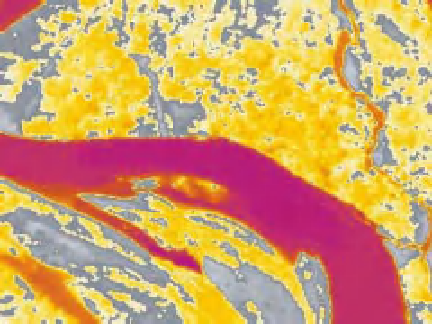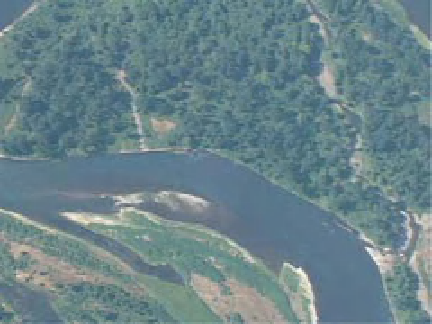Geography Reference
In-Depth Information
(a)
Spring-
brook
125 m
(b)
Cool
Warm
15
°
C
20
°
C
25
°
C
Figure 5.3
Natural-color (a) and airborne TIR (b) aerial images showing thermal heterogeneity in a complex floodplain of the
Willamette River (Oregon, USA), which flows through a large, low-elevation agricultural valley (22 July 2002). See Figure 5.1 for
clarification of color and grayscale thermal classification. Radiant water temperature varies laterally from the cooler and relatively
homogeneous thalweg and main channel to warmer backwaters and disconnected channels. A springbrook is apparent where
relatively cooler hyporheic flow emerges from the unconsolidated substratum of a large riverine island (Oregon Department of
Environmental Quality 2006; Watershed Sciences, Inc., Corvallis, Oregon, USA).
later section). Where mixing in the water column occurs,
cooler water can be detected at the surface, but few stud-
ies have determined
in situ
the necessary water velocities
and fluvial morphology required to fully mix the vertical
structure of the river. Further investigation of the vertical
dimension may be conducted in winter when groundwa-
ter, which at this time is warmer than river water, is more
likely to rise to the surface due to its lower density. Few
studies have collected TIR images of rivers and streams in
winter, but this area of inquiry holds much potential for
quantifying surface water and groundwater interactions
and identifying 'warm-water' refugia for fishes in cold
regions (Tockner, 2006).
Comparisons of TIR images in rivers across seasons
and years provides a means to assess changes in the ther-
mal landscape associated with habitat degradation or to
evaluate the effectiveness of floodplain restoration. The
application of TIR remote sensing in restoration ecol-
ogy of rivers is uncommon (for a notable exception see
Loheide and Gorelick, 2006) but will likely gain momen-
tum as rivers that were surveyed aerially in the 1990s
are re-flown to monitor the effectiveness of management
actions (e.g., channel modification and re-vegetation of
riparian areas) at restoring thermal diversity in riverine
landscapes. The following sections provide the techni-
cal context and practical applications of TIR remote







Search WWH ::

Custom Search